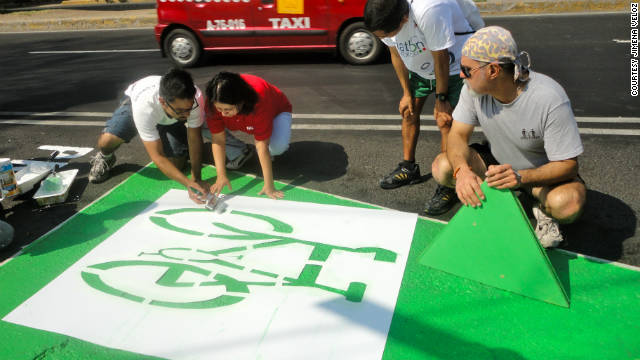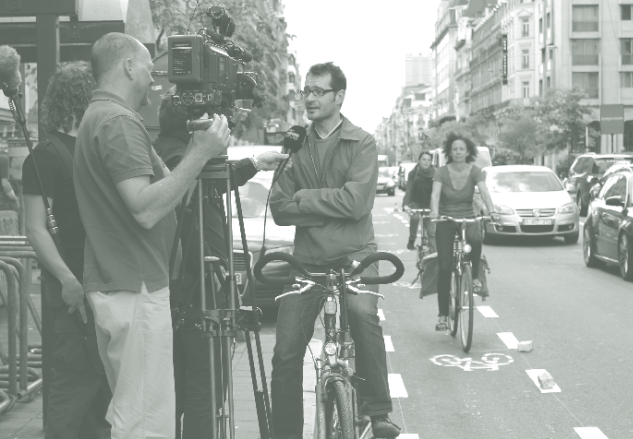
How Do You Get Journalists to Love Cycling? ECF Great Debate
This is the second edition of our Great Debate. Go to the end of the article to see how you can make your voice heard.
Media, Media, Media. It can be a cycling advocacy group’s worst nightmare, and equally their best friend. Journalists can be the driving force for change, and they can prevent a bicycle path from being built. They can paint cyclists to be the menace of the road, or conversely, the saviors of congested transport systems.
In this edition of the great debate, ECF is asking our readers, how do you get a journalist to love cycling? Should you focus on cycling? Should you be creative? Should you even bother talk about cycling?
The Times Campaign: Change at Hand
 Ah, the recent Times campaign. There’s little doubt that they’ve so far managed to garner significant political attention. This drive for change has been largely thanks to the journalists behind the campaign*. And it's difficult to comprehend the mammoth change in attitude by the paper. It was only in 2008 that they ran an article on "decapitating cyclists".
Ah, the recent Times campaign. There’s little doubt that they’ve so far managed to garner significant political attention. This drive for change has been largely thanks to the journalists behind the campaign*. And it's difficult to comprehend the mammoth change in attitude by the paper. It was only in 2008 that they ran an article on "decapitating cyclists".
Reporting in the Guardian , James Randerson articulates: "this kind of campaign is so out of character for the Times. This is a news organisation that sees itself as a sober paper of record – not a strident campaigning voice".
So how did this change in attitudes come about? And what are the best ways for advocates to encourage such shift in attitude.
Make Cycling Sexy
If Mikael Colville Andersen from Copenhagenize had a plan to get journalists on side, there’s little doubt that it’d be to make cycling sexy. Here at ECF, we receive many calls for journalists interested in the Cycle Chic movement and there's little doubt that sexy and cycling create a good media mix.
Well known Journalist and Author, Carlton Reid seems to confirm this saying that in mainstream media “cycle chic style articles tend to be the ones that get commissioned”.
DIY Bicycle Infrastructure
Last year, journalists were rather excited by DIY Bicycle infrastructure. For example in Mexico last year, some activists painted an unauthorised five-kilometre path to the foot of the city’s Congressional Hall after local government stalled on its promise to build 300 kilometres of cycle lanes. It generated substantial positive media coverage from CNN. Other examples such as a 30 km/h sign on a house in Britain, and in Brussels, Belgium sticky tape bicycle paths also proved useful in generating positive media coverage.

DIY Bicycle Paths in Mexico City Photo: CNN
Secret Cyclists…
Adam Bodor, former Cycling Commissioner of Hungrary, and ECF staff member shared some of his experience with us:“The best coverage I received was from journalists who were cyclists. Cycling journalists often influenced their non-cycling colleagues. It was like a secret network," Bodor says.
Making journalists feel like experts also proved to be a winning formula.
Bodor explains that “involving them in workshops and making them feel like an expert proved to be very effective. This would generate positive coverage and helped us to involve their colleagues as well.”
Don’t talk about the cyclists
In a recent interview, liveable city consultant Gil Penalosa told ECF that if you want promote cycling “don’t talk about cyclists.”
He continues to say, “Imagine that you have a city with 2% cyclists and 60% of people using cars people. People will say you are against the 60%,” says Peñalosa.
In our own experience this 'don't mention the cyclist' approach can sometimes work.
When the EU parliament adopted a resolution on 30 km/h zones, our Policy officer, Fabian Kuster told the media: “It’s about politicians creating cities for living in rather than thoroughfares for vehicles,”
This statement was mirrored by the mainstream press, also being picked up by Reuters News agency as well as a selection of EU media. Let’s be honest, who can argue against making a city more people friendly?
Returning back to journalist Carlton Reid, he wrote last year in the magazine Cycling Mobility:
"When a British Politician hears cyclists calling for dedicated infrastructure, more often than not they picture a cyclist running a red light, or buzzing pedestrians"
He continued on to say: "the obvious route is not always the best. If your goal is to make your city more cycling friendly, it is sometimes better not to highlight cyclists"
So, can the same be said when trying to convince journalists? If to we want to make them see cycling as something good, should we perhaps not talk about cycling?
Join the Debate
Tell us what tickles a journalists’ fancy? What makes them cast cycling in a positive light? Will some journalists always hate cycling?
We can’t wait to hear your opinion: Tweet #ecfgreatdebate and tell us what you think
Post on our Forum and also have your say on our Facebook page.
You can also send us an email with the subject line: ECF Great Debate to communications@ecf.com, and we’ll post you’re query on our forum.
Julian Ferguson is the Communications Officer for the European Cyclists’ Federation. Originally hailing from Australia and a keen bicycle advocate, he plans one day to ride his bicycle from Brussels to Melbourne
* It of course shouldn't be forgotten that the campaign came about because one of journalists within the organization was involved in a horrific accident. But surely there’s more to it than this?
Contact the author
Recent news!
Upcoming events
Contact Us
Avenue des Arts, 7-8
Postal address: Rue de la Charité, 22
1210 Brussels, Belgium













